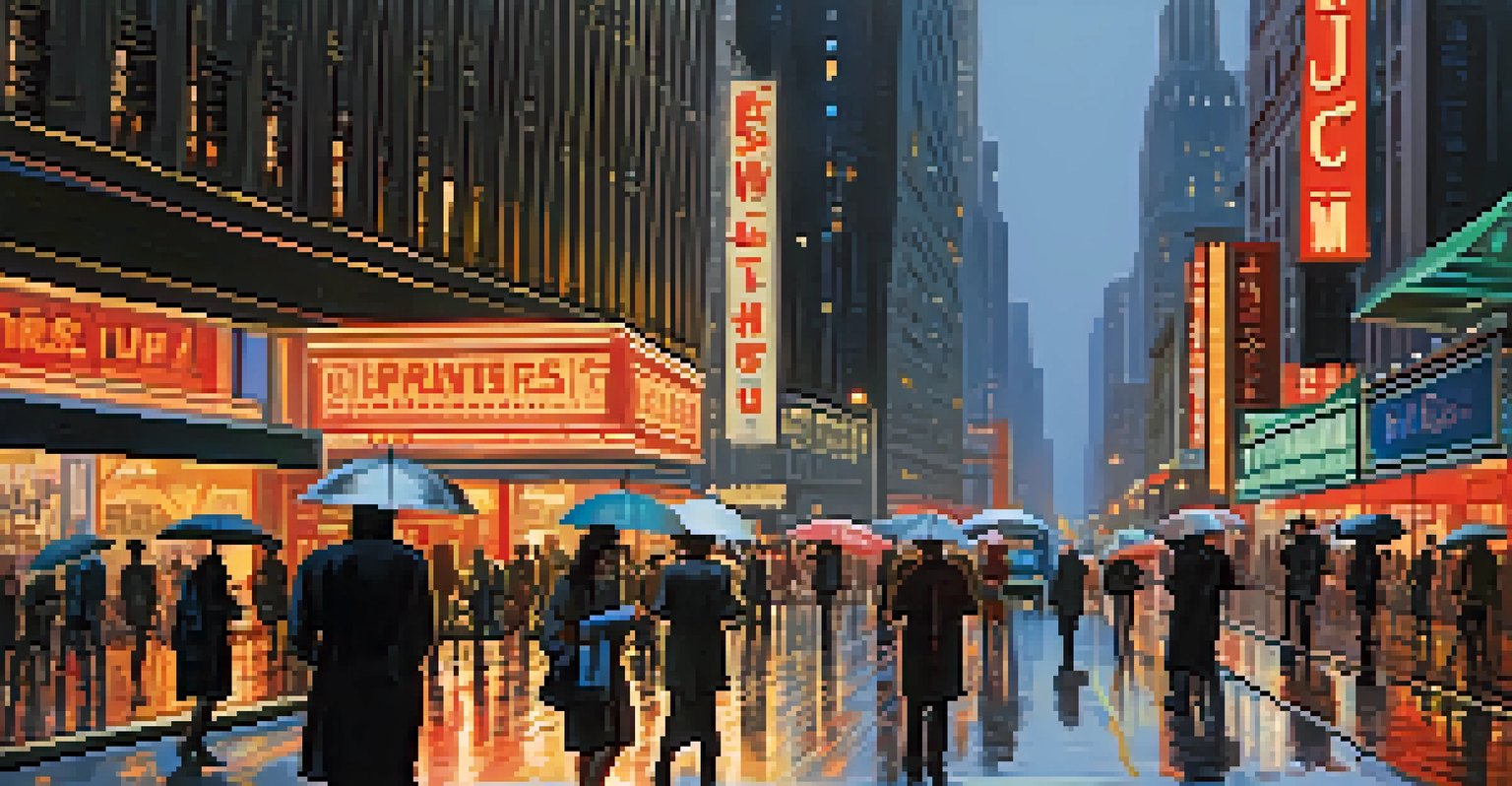Art Movements: Evolution of Concepts in Artistic Expression

Understanding Art Movements: A Brief Overview
Art movements are defined as a group of artists sharing a common philosophy, style, or goal during a specific period. They reflect the social, political, and cultural climates of their times, offering a window into history through visual creativity. Each movement acts as a response to the previous one, evolving concepts and techniques in artistic expression.
Every artist dips his brush in his own soul, and paints his own nature into his pictures.
For example, the transition from the realism of the 19th century to the abstract styles of the 20th century highlights how artists began to challenge traditional representations of reality. Movements often emerge as reactions to prevailing norms, pushing boundaries and inviting viewers to see the world from new perspectives. Understanding these movements is crucial for anyone looking to appreciate the deeper meanings behind artworks.
Related Resource
As we delve into various art movements, we will see how they not only shaped the artists' identities but also influenced societal views on art itself. This exploration will reveal the interconnectedness of creativity and societal evolution, showcasing how art is much more than mere aesthetics.
Renaissance: The Rebirth of Classical Ideals
The Renaissance, spanning from the 14th to the 17th century, marked a significant revival of classical learning and wisdom. Artists like Leonardo da Vinci and Michelangelo focused on humanism, portraying the beauty of the human form and the intricacies of nature. This movement emphasized balance, proportion, and perspective, setting a new standard for artistic excellence.

One defining characteristic of the Renaissance was the use of linear perspective, which gave depth to paintings, making them more lifelike. This technique transformed how artists approached composition, allowing viewers to immerse themselves in the scene. The Renaissance also saw a shift towards secular themes, with more emphasis on individual experiences and emotions rather than solely religious narratives.
Art Movements Reflect Society
Art movements evolve as responses to societal, political, and cultural changes, offering insights into the time periods they represent.
Ultimately, the Renaissance laid the groundwork for future movements by encouraging creativity and the exploration of new ideas. The desire to blend art with science during this time foreshadowed the innovations that would continue to shape artistic expression in the centuries to come.
Baroque: Embracing Emotion and Drama
The Baroque period, flourishing in the 17th century, is characterized by its dramatic use of light, color, and movement. Artists like Caravaggio and Peter Paul Rubens created works that evoked emotion and drew viewers into the narrative. This movement aimed to inspire awe and create a visceral connection with the audience, often employing exaggerated gestures and intense contrasts.
Art is not freedom from discipline, but disciplined freedom.
Baroque art often reflected the tension and triumphs of the time, including the struggles of the Reformation and Counter-Reformation. The grandiosity of Baroque architecture and painting served to communicate power and divine presence, often commissioned by the Church and wealthy patrons. This period also saw the rise of still life and genre painting, celebrating everyday life and its beauty.
Related Resource
Through its emphasis on emotion and dynamism, Baroque art set the stage for future movements like Romanticism, where feelings and individual experiences continued to take center stage. The legacy of Baroque art remains evident in how artists convey narrative and emotion even today.
Romanticism: The Power of Individual Emotion
Emerging in the late 18th century, Romanticism was a reaction against the rationality of the Enlightenment and the constraints of the Industrial Revolution. Artists such as Eugène Delacroix and J.M.W. Turner celebrated nature, emotion, and the sublime, emphasizing the individual's experience over collective reasoning. This movement sought to capture the intensity of human emotions and the beauty of the natural world.
Romantic artists often portrayed dramatic landscapes and historical events infused with passion, aiming to evoke strong feelings in their viewers. The use of vibrant colors and dynamic compositions became signature elements of Romantic art. This movement also coincided with a growing interest in folklore and the exotic, further diversifying the themes explored in art.
Renaissance Sparked Artistic Innovation
The Renaissance revived classical ideals, emphasizing humanism and perspective, which laid the groundwork for future artistic exploration.
Romanticism's legacy is profound, influencing not only the arts but also literature and music. Its focus on individualism and emotional expression paved the way for later movements, reminding us that art serves as a powerful means of personal and societal reflection.
Impressionism: Capturing Fleeting Moments
Impressionism emerged in the late 19th century, challenging traditional techniques and perspectives in painting. Artists like Claude Monet and Edgar Degas sought to capture the fleeting effects of light and color rather than focus on fine details. This movement emphasized the importance of perception, encouraging artists to paint en plein air, or outdoors, to better capture the essence of a moment.
The brushwork of Impressionist artists was often loose and spontaneous, creating an impression of movement and changing conditions. This approach allowed viewers to experience the world as the artist perceived it, emphasizing the beauty in ordinary scenes. Impressionism also broke away from historical and mythological subjects, showcasing everyday life and landscapes in a fresh and innovative way.
Related Resource
Impressionism was initially met with criticism but eventually paved the way for modern art movements. Its focus on perception and experience continues to resonate with contemporary artists, highlighting the ongoing evolution of artistic expression.
Modernism: Redefining Art and Its Purpose
Modernism, which began in the late 19th century and continued through the mid-20th century, marked a radical departure from traditional artistic conventions. Artists such as Pablo Picasso and Marcel Duchamp sought to challenge the very definition of art, experimenting with form, abstraction, and conceptual ideas. This movement was characterized by a belief in progress and a desire to represent the rapidly changing world.
One of the hallmarks of Modernism was the embrace of abstraction, leading to the creation of movements like Cubism and Surrealism. Artists began to explore the subconscious mind and the complexities of human experience, often utilizing unconventional materials and techniques. This period also saw the rise of art movements focused on social commentary, reflecting the political turmoil of the time.
Postmodernism Emphasizes Diversity
Postmodernism challenges traditional narratives and celebrates diverse expressions, reflecting a shift towards pluralism in art.
Modernism's legacy is vast, influencing countless artists and movements that followed. Its challenge to norms opened the door for post-modern expressions, reshaping how we understand and appreciate art in the contemporary landscape.
Postmodernism: Breaking Boundaries and Embracing Diversity
Postmodernism emerged in the late 20th century as a response to the principles established by Modernism. This movement is characterized by its skepticism towards grand narratives and ideologies, celebrating diversity and pluralism in artistic expression. Artists like Andy Warhol and Cindy Sherman utilized irony and playfulness to question the nature of art and its role in society.
One key aspect of Postmodernism is the blending of different styles and media, often incorporating elements from various cultures and historical periods. This eclectic approach allows for a more inclusive understanding of art, where traditional boundaries are blurred, and new forms of expression emerge. Postmodern artists often challenge the idea of originality, emphasizing the importance of context and interpretation.

The influence of Postmodernism is evident in various contemporary art forms, including digital art and street art. Its focus on questioning established norms and celebrating diversity continues to shape the evolving landscape of artistic expression today.
The Future of Art Movements: Continuous Evolution
As we look ahead, the evolution of art movements shows no signs of slowing down. Contemporary artists are responding to global issues such as climate change, social justice, and technological advancements, creating new dialogues through their work. This ongoing evolution reflects the dynamic nature of art, where innovation and creativity thrive.
The rise of digital art and social media has transformed how artists connect with audiences and share their work. These platforms allow for a greater exchange of ideas, fostering collaboration and experimentation across different artistic disciplines. As a result, new movements are emerging that challenge traditional definitions and invite diverse perspectives.
Ultimately, the future of art movements will continue to be shaped by the societal context in which they arise. As artists explore new mediums and concepts, they will keep pushing the boundaries of expression, reminding us that art is an ever-evolving dialogue between the individual and the world.